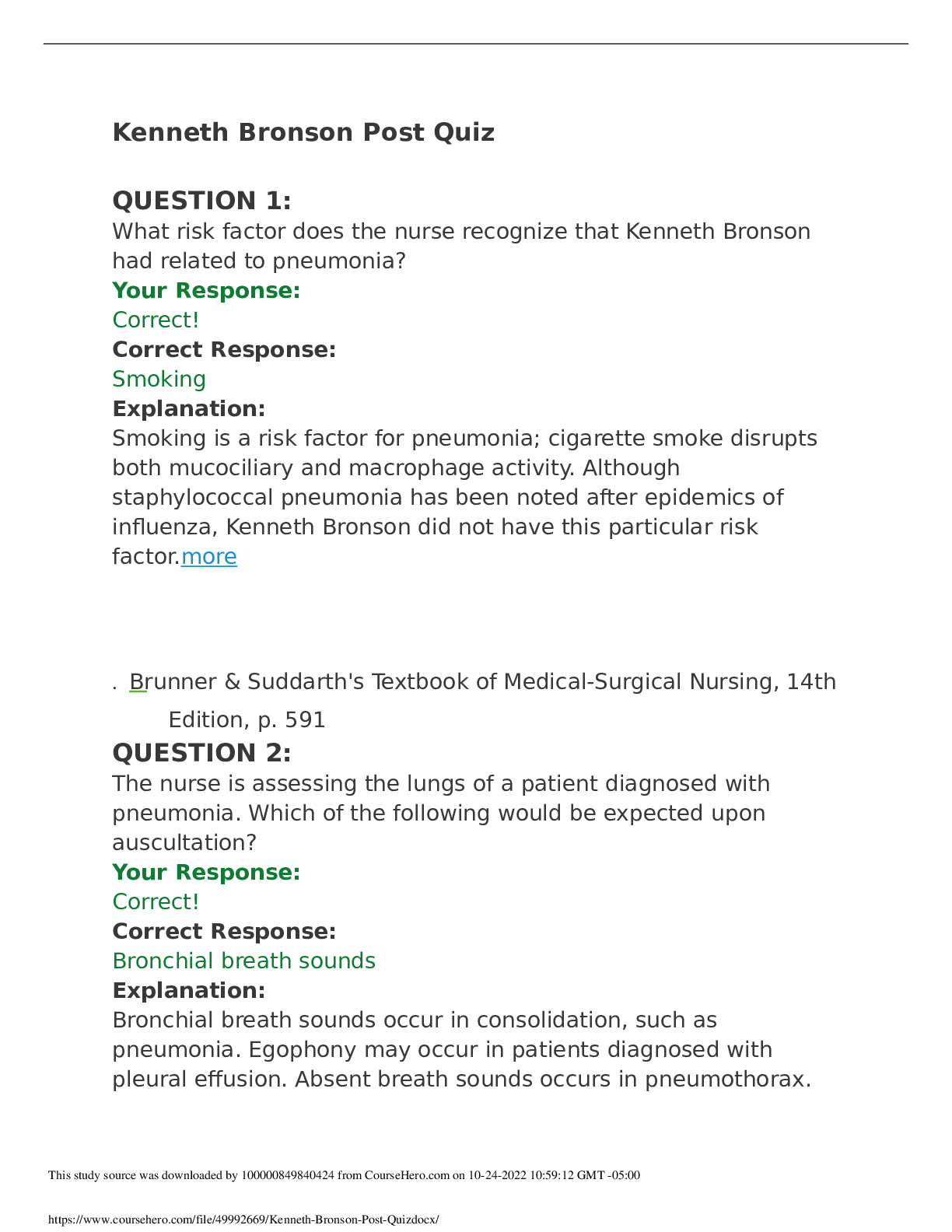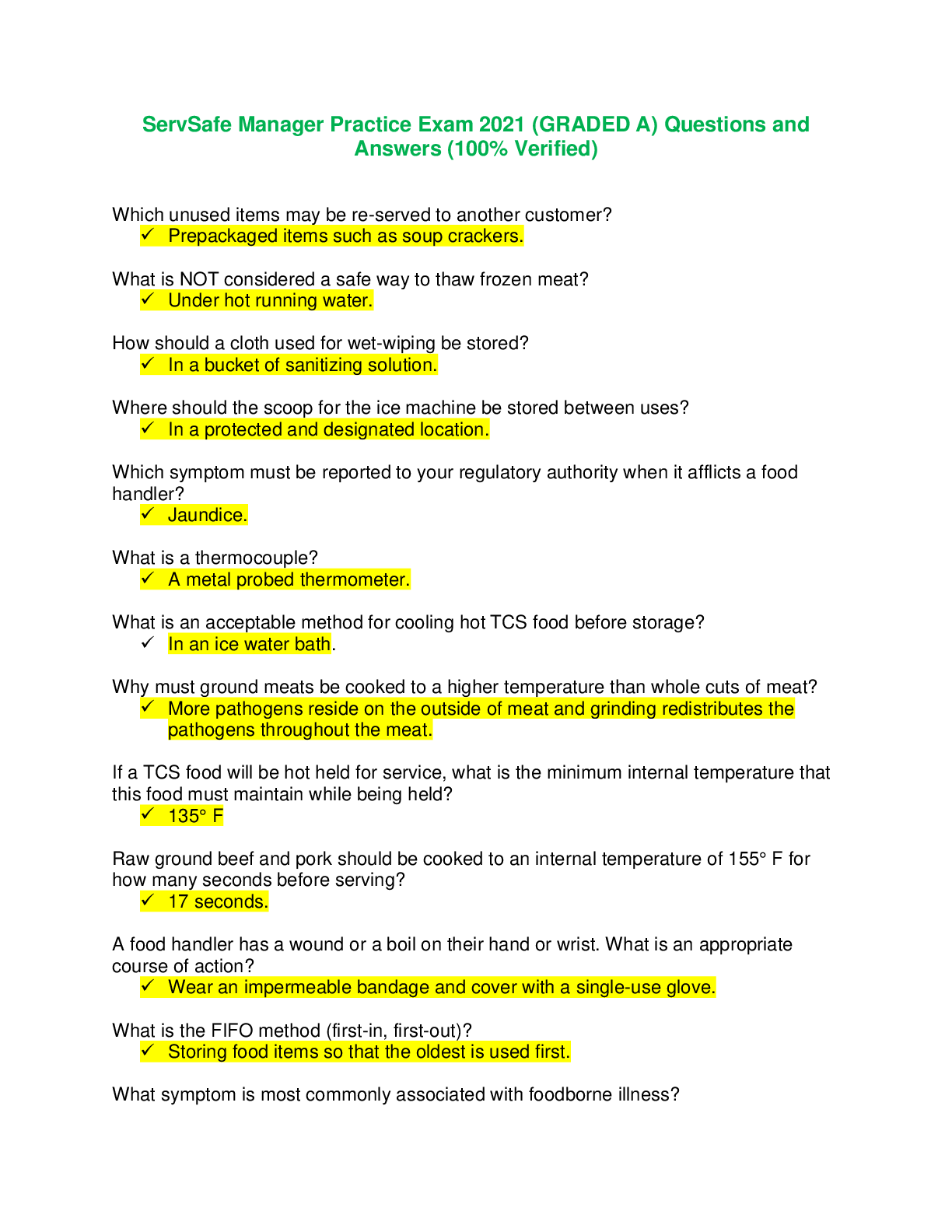Microeconomics > EXAM > ECON 212 _Chapter 4: Essential Microeconomics Tools - Exam Q&A | (Download To Score An A) (All)
ECON 212 _Chapter 4: Essential Microeconomics Tools - Exam Q&A | (Download To Score An A)
Document Content and Description Below
Chapter 4: Essential Microeconomics Tools - Sample Exam Questions 1 The demand curve for an individual shows how the marginal utility of consuming an extra unit of the good declines as total consum... ption rises. B) False 2 A firm’s marginal cost curve is also its supply curve when the firm acts in a perfectly competitive manner. B) False 3 Since the supply curve is the marginal cost curve, the area under the supply curve up to a particular level of output shows the cost of producing that level of output (ignoring fixed costs). B) False 4 The demand curve reflects the marginal utility of consumption since firms set prices equal to marginal cost. B) False 5 The supply curve shows marginal cost since consumers buy goods up to the point where their marginal utility equals the price. B) False 6 Consumer surplus corresponds graphically to the area located below the demand curve and above the cost of purchasing the goods - since this measures that amount of utility people get from consuming the goods in excess of what they pay for the goods. B) False 7) Under perfect competition, the fact that the price is set by the intersection of the supply and demand curves means that the marginal cost of producing an extra unit to the good is exactly equal to the marginal utility of consuming an extra unit. B) False 8 The import demand curve is: A) always upward sloping. B) the horizontal difference between the domestic demand and supply curves. C) the vertical sum of the domestic demand and supply curves. D) a reflection of the cost of producing the imported goods. 9 The import supply curve is: A) usually downward sloped. B) a reflection of how much it costs foreigners to supply the goods. C) the horizontal difference between the domestic demand and supply curves D) the marginal value of foreign consumption. 10) When the price of imports fall, the home nation gains on net because: A) it pays less for the goods it was already importing and it gets some surplus on the increased volume of imports. B) In fact, a nation is hurt by cheap imports. C) the higher level of imports that results allows higher levels of consumption and higher levels of domestic production. D) the import supply curve is upward sloped. 11) The border price effect shows how much the nation would gain or lose from an import price change assuming there is no change in: A) the volume of imports. B) the terms of trade. C) the level of the tariff. D) domestic consumption. 12) The trade volume effect shows the welfare effects of a change in the volume of imports, ignoring the impact of the price change on: A) the initial level of imports. B) domestic production. C) foreign welfare. D) tariff revenue. 13 A tariff tends to drive down a nation’s border price since it: A) reduces the volume of imports and this pushes foreigners down their supply curve. B) improves the efficiency of domestic producers. C) leads domestic consumers to consume more. D) is fully passed on to domestic consumers. 14 If the price of a nation’s exports rise, it gains on the whole even though consumers and producers . A) win, lose B) have no gains, win C) lose, win D) win, have no gains 15) If the price of a nation’s imports rise, this is for domestic producers and for domestic consumers. A) bad, good B) neutral, good C) good, neutral D) good, bad 16 Taking account of domestic and foreign welfare changes, the overall impact of a tariff A) is positive B) is neutral C) is negative D) depends on the relative sizes of the trade volume and the border price effects 17) The equilibrium border price is where the import supply and import demand curves meet. A) True B) False 18) An MFN tariff is non-discriminatory tariff A) True B) False 19) Although the unilateral imposition of a tariff may improve the home nation’s welfare, the tariff harms the foreign nation than it helps the home nation. A) True B) False 20) Imposing a tariff unilaterally on imports may improve a nation’s welfare because, the tariff is, in effect, paid by foreigners. A) True B) False 21 Discuss the Cassis de Dijon case (p. 133) 22 Discuss why do frictional barriers arise so often (p. 134) Guide answers to Self-assessment questions 1 Using a diagram like Fig. 4.7, show the full Foreign welfare effects of imposing a Home tariff equal to T, i.e. show the impact on Foreign producers and Foreign consumers separately. Answer: The key new point is that a Home tariff helps foreign consumers and harms foreign producers since it lowers the foreign internal price. The Welfare effects are summarized by the right hand side diagram of Figure 4.7. Foreign consumers gain while foreign producers lose because of the fall in border prices. The net effect is negative. 2 In August 2005, EU clothing retailers such as Sweden’s H&M complained about the new EU restrictions on imports from China that were imposed after complaints from EU clothing producers based in Italy, France, Spain, Portugal and Greece. Use a diagram like Fig. 4.7 to explain the positions of the various EU interest groups. Answer: The key point is that import restrictions benefit producers while damaging consumers. 3 One way to think about the slope of the MS curve is in terms of the ’size’ of the home nation. The idea is that the demand from a very small nation has a very small impact on the world price. For example, Switzerland could probably increase its oil imports by 10 per cent without having any impact on the world oil price. Using a diagram like Fig. 4.7, show that the welfare costs of imposing an MFN tariff are larger for smaller nations, interpreting this in terms of the MS curve’s slope. Show that when the MS curve is perfectly flat, the welfare effects are unambiguously negative. Answer: This is just the standard, small-nation tariff analysis. 4 Using a diagram like Fig. 4.7, show that a country facing an upward-sloped MS curve can gain – starting from free trade – from imposing a sufficiently small tariff. (Hint: Starting from a small tariff, the rectangle gains and triangle losses both increase in size as the tariff gets bigger, but the rectangle gets bigger faster.) Show that any level of a frictional or FCR barrier lowers Home welfare. Answer: The first part is just the standard argument that the ‘optimal tariff’ for a ‘large’ nation is non-zero; the key is that for a very small (infinitesimal) tariff, the dead-weight loss triangles are second- order small and so can be ignored, but the border price effect (terms of trade effect) is first-order small. In the second part, there is no trade price gain since, although the frictional barrier lowers the price that foreigners receives, the price that the home country pays rises (the domestic and border price are the same for an MFN frictional barrier). What this means is that although the loss from an infinitesimally small frictional barrier is zero, the loss becomes noticeable for any finite barrier. 5 Using the results from the previous exercise, consider the impact of Home imposing a tariff on Foreign exports and Foreign retaliating with a tariff on Home’s exports. Assume that the MS and MD curves for both goods (Home exports to Foreign and Foreign exports to Home) are identical. Starting from a situation where Home and Foreign both impose a tariff of T, show that both unambiguously gain if both remove their tariffs, but one nation might lose if it removed its tariff unilaterally. By the way, this exercise illustrates why nations that are willing to lower their tariffs in the context of a WTO multilateral trade negotiation are often not willing to remove their tariffs unilaterally. Answer: This can be answered in a very elegant manner using a diagram like the second panel of Figure 4-7 where the home and foreign welfare impact of an MFN tariff can be seen together. Given the symmetry, the transfers (areas J and L) net out, leaving only the deadweight losses K and M. The last point illustrates the prisoner’s dilemma aspect of trade negotiations. 6 Using a diagram like Fig. 4.5, show that an import tariff equal to T has exactly the same impact on prices, quantities and welfare as a domestic consumption tax equal to T and a domestic production subsidy equal to T. (Hint: A production subsidy lowers the effective marginal cost of domestic firms and so lowers the domestic supply curve by T.) Answer: This is the standard tax-cum-subsidy view of a tariff. The easiest way to show it is to view the consumption tax as lowering the domestic demand curve by T and the subsidy raising the domestic supply curve by T. Prices, quantities and tax receipts net of the subsidy are identical to those under a tariff equal to T. 7 Using a diagram like Fig. 4.7, show the impact on quantities, prices and welfare when Home has no tariff, but Foreign charges an export tax equal to T. Answer: Using the fact that the border and domestic price are the same for Home, but different for Foreign, this is a simple exercise once the MS curve is shifted in the left direction. The Home sees its MS curve shift up by T, this raises the domestic and border price and reduces the price received by foreign producers. Foreign may gain or lose from this, depending upon whether the export tax revenue exceeds the dead weight loss triangle; a gain would be an example of the foreigners exploiting their market power. 8 Using a diagram like Fig. 4.5, show the impact on quantities, prices and welfare when Home has no tariff, but Foreign imposes an export quota with a tariff-equivalent of T. Answer: See section 4.4.1 and Figure 4.9 of the text for the basic analysis here. 9 Using a diagram like Fig. 4.7, show that the welfare effects of a quota that restricts imports to M′ are exactly the same as a tariff equal to T; assume that each quota licence (i.e. the right to import one unit) is sold by the government to the highest bidder. Answer: See section 4.4.1 and Figure 4.9 of the text for the basic analysis here. The answer should underline the fact that the trend rents are captured by the domestic government (the area A+B in Figure 4.9) [Show More]
Last updated: 2 years ago
Preview 1 out of 5 pages
.png)
Buy this document to get the full access instantly
Instant Download Access after purchase
Buy NowInstant download
We Accept:

Reviews( 0 )
$8.50
Can't find what you want? Try our AI powered Search
Document information
Connected school, study & course
About the document
Uploaded On
Mar 28, 2021
Number of pages
5
Written in
Additional information
This document has been written for:
Uploaded
Mar 28, 2021
Downloads
0
Views
82





 Questions and Answers 100% VERIFIED.png)
 Questions and Answers 100% correct Solutions.png)

















.png)

